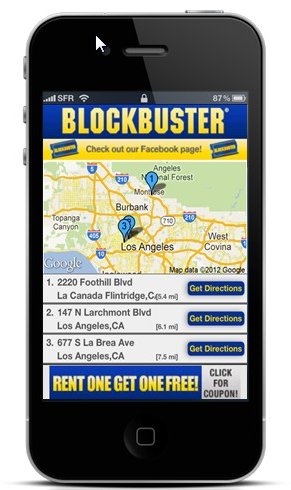An ongoing battle cry in the world of mobile local search is how location targeting can boost performance and bring higher premiums to mobile ads. That goes for both search and display ads, and represents a growing batch of mobile ad networks and ad tech providers.
Last week, YP became the latest in that batch to develop not only better location targeting, but new ad units meant to better capture mobile local user intent. Google has reported that 40 percent of mobile searches are local (compared with 20 percent on desktop).
I had the chance to catch up with YP’s VP of publisher products David Kurtz at this week’s IAB Conference to get more color on these new ads, and what they mean for both national (brands) and local (SMBs) advertisers that want to localize mobile campaigns.
Scale Advantage
YP’s main new feature is a store locator launched from display ads. The correct nearby locations and details for a given chain are automatically displayed on customized landing pages, based on where the user happens to be standing.
Google offers something similar with its Local Extensions that let national businesses upload individual store information so that nearest locations show up in mobile and local searches. YP is positioned well here with an existing location database to utilize.
Store locators also are nothing new, admits Kurtz, but a powerful tool within the largest mobile local ad network in the U.S. This scale allows YP to get over the traditional local segmentation challenge; where reach is sacrificed when ads are targeted locally.
“We’re in good spot to do this,” Kurtz said. “Store location on mobile isn’t new, nor is dynamic campaign generation. But we’re the first to be able to do it at scale with all the assets in one place finally.”
This scale also puts YP in a good knowledge position, using large data samples to optimize campaigns on an ongoing basis. In a recent trial with Blockbuster, for instance, it modified ads where “secondary actions” (i.e., calls, clicks, maps) were performing best.
“We paused the campaign mid-stream,” Kurtz said. “Not because CTRs weren’t good, but because we wanted to optimize campaigns in geos where the secondary actions are higher.”

Proof Points
In order to make sure YP is providing the greatest value to advertisers, Kurtz says that it asks advertisers to choose from a list of actions they want to drive. These of course vary per business and include things like calls, directions, and clicks.
These can provide a clearer sense of ROI to merchants and could in the future represent CPA pricing models. But for now, Kurtz maintains that advertisers’ comfort levels lie more with CPC and CPM pricing. Secondary actions are more to show campaigns are working.
This was proven in the Blockbuster trial which saw CTRs around .05 percent (average online CTRs are about.01 percent). Fifty-five percent of those clicks launched a map while 20 percent clicked on a coupon. Twenty-two percent of those coupon clicks were shared with friends.
Also sweetening the deal is automatic landing page generation and optimization. Kurtz claims they can be built in under 48 hours and only require a company logo and images. Brand-appropriate color palettes are automatically generated.
“We take those assets in, and almost overnight we can have them up and running with an optimized landing page,” Kurtz said. “From there we can continue to push users down the funnel, to visit a business.”
Heads or Tails
This is all great for large national advertisers with dispersed locations because it allows them to infuse local relevance dynamically and at scale. That localization has been known to boost ad performance through other ad networks; and YP’s trials further support it.
After these ads prove themselves with national advertisers, their location-centric nature could make them applicable to the long tail of local SMBs. But for now, YP is sticking with the easier advertiser and user acquisition that’s inherent with national brands.
“It’s still early days, but reaching local consumers and getting them to interact with SMBs is tough,” Kurtz said. “With nationals, it’s a bit easier because their branding is more known.”
This comes with at least a little irony for a company whose legacy is known for local print media squarely aimed at SMBs. But its a logical step in an ongoing evolution of local media and local search — being not just “locals only” now more than ever.
